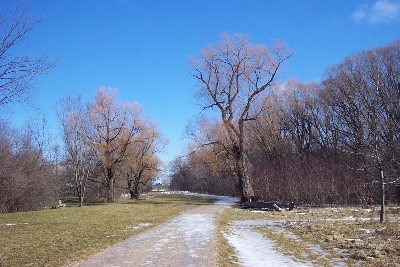The poet as prophet
This article was first published in two parts in Living With Nature at Suite101.com on Feb. 4 and 11, 2000. It has here been revised and updated.
The internet is replete with resources on nature
writing. But thoughtful treatments of nature poetry as a genre are scarce.
Some of my writing colleagues practically dismiss it as a tired cliché.
Perhaps the greatest work of nature writing of the 20th Century was
Annie Dillard's 1974 Pulitzer Prize-winning Pilgrim at Tinker Creek.
Though a work of non-fiction prose, Dillard's poetic voice echoes clearly
throughout the work. She explores poetry directly in her 1988 volume, Tickets
for a Prayer Wheel.
It came as a great surprise to me to read the cynicism toward Dillard's
writing expressed in the essay Urban
nature: teaching Tinker Creek by the East River, by Michael
Bennett, an instructor at Long Island University. He got preoccupied with
the resistance his students felt for Dillard's vision. Her ecocentrism
is identified as failing to "consider that the inhabitants of urban places
are as much a part of an ecosystem" as those idealistic writers who wander
open spaces.
 |
Everyone has the right of access to nature, part of our common heritage. Adequate urban planning ensures that no one is isolated from it. An outstanding example is this naturalized riverside park that runs through the heart of the city of Guelph, Ontario.
|
But in criticizing Dillard and Walt Whitman, Bennett has missed one
of the essential messages of nature writers over the past two centuries.
UK poet laureate Andrew Motion said, "Poetry itself is a very primitive
and essential need." I believe this need could be extended to include a
poetic experience of nature, and of our true relationship with the Earth.
Kentucky poet and farmer, Wendell Berry, has said, "Urban people are connected
to the land by their gastrointestinal tract." This is hardly a holistic
relationship.
As one who has lived both on and off the land, I can understand why
urbanites struggling against poverty might resent a naturalist's apparent
privileges. But I also believe that economic problems are closely tied
to neglect of our relationship with nature. By creative exertion, this
connection can be restored.
In her book Cultivating Sacred Space: Gardening for the Soul, Elizabeth Murray gives an account
of one landscape artist and a marginalized north Philadelphia community
that experienced this transformation together. Murray calls Lily Yeh, "a
modern-day alchemist," whose pursuit of artistic expression led to the
creation of The Village of Arts and Humanities. Since 1986, 55 vacant properties
have been converted into "parks, gardens, education facilities, offices,
and low income housing."
While Bennett questions whether there is such a thing as urban nature,
others like Yeh are busy finding it.
Any art form runs the risk of not touching its audience. This is where
creative writing can fail. Anyone who sees a flower or sunset can describe
its beauty. The task of the nature poet is to relate what he or she perceives
to broad human experience, and in language that can be understood universally.
But the audience might have other things on its collective mind. In
crisis situations it takes an inspired Mr. Holland to show his students
the value of music. It seems to me that Bennett may have failed the students
of Long Island University in this regard.
"Most of all, I love being alive.
I love the natural world—and caring and creative people—
and the seekers of justice and truth."
–Stanley Kunitz
The best nature poetry is neither overly sentimental nor coldly scientific.
Like any genre, it looks out at the world and sees a reflection of the poet's
own existence. Then, from personal revelation, it expands and speaks to all humanity.
Nature is close to the heart of a great many poets. They are not necessarily
naturalists, ecologists or environmentalists. Mark Doty
often writes about the urban landscape, yet his poem A green crab's shell
is an excellent contemporary example to begin this exploration of nature poetry.
He refers to the lapis lazuli blue, what he calls
a colour of "intensity and power," used by the Renaissance painter Giotto to represent heaven.
Annie Dillard's skill of the art of noticing, described by David Lavery,
lies at the heart of nature poetry. This is where, "you have to know your stuff,"
she told essayist Fred Musante.
But even her knowledge is not professional. It flows from a passion to perceive, to know,
and to understand. Dillard's
informed vision allows her readers to explore the power of both nature and the human mind.
Although better known for her non-fiction writing, a poetic voice can be heard throughout
her writing. Dillard (b. 1945) has published a book of poetry,
Tickets for a Prayer Wheel. An example of her poetry is
I am trying to get at something utterly heartbroken.
Some of my earliest poetic inspiration came from
Luci Shaw.
Although I no longer share her evangelical Christian perspective, I still appreciate
how she uses vivid images of nature to express her ideas, as in Beachcombing.
Identified by the New York Times as the "prophet of rural America,"
Wendell Berry
(b. 1934) is a strong advocate of conservation and responsible land use.
His deep regard for nature, as in the poem The Peace of Wild Things,
has been another inspiration for me as a writer.
Bill Moyers' book, Fooling With Words, recently introduced me to Stanley Kunitz (b. 1905), whose work continues to influence the poetry community in North America. Read his joyful word gardening poem, The Round.
These modern poets have built on the groundwork laid by masters of the past, several of whom are listed below. One of the greatest of these is Ralph Waldo Emerson, whose belief in the power of the individual has deeply influenced American culture and politics. One of his most beautiful nature poems is The Rhodora.
All written material and images are ©1997-2002 Van Waffle. This page updated Apr. 16, 2002.
